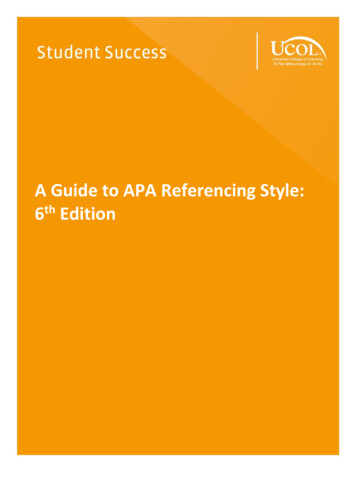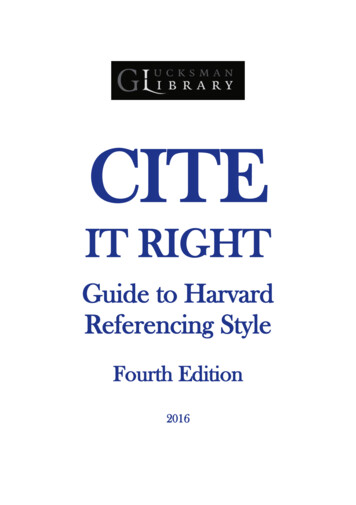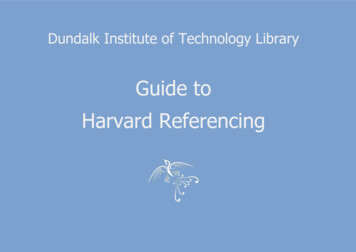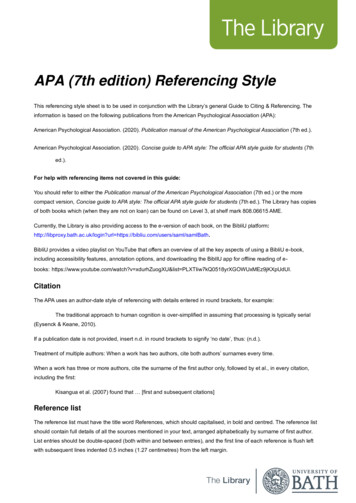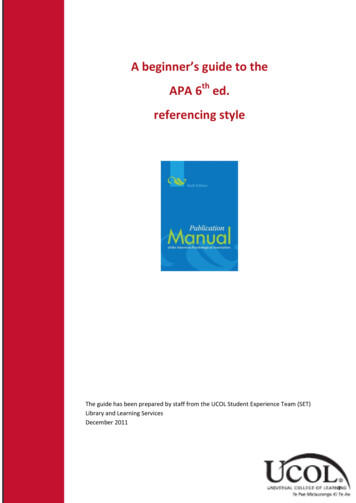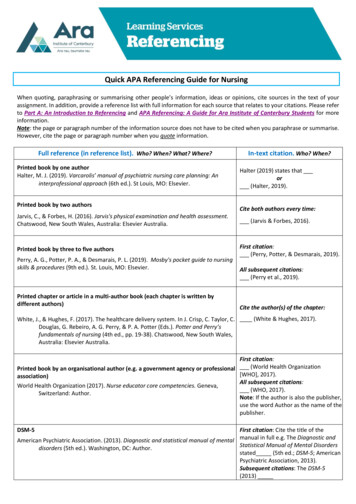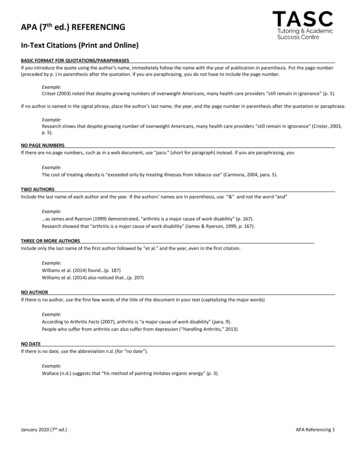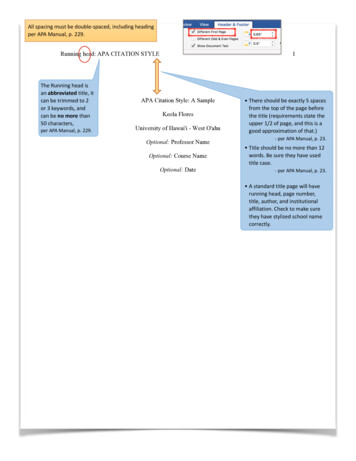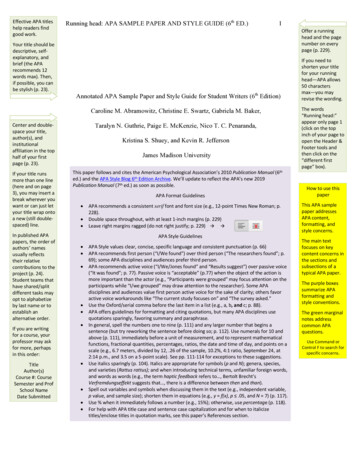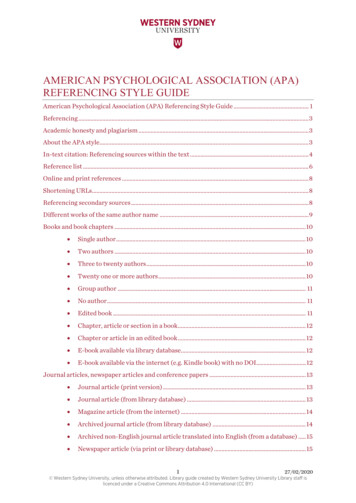
Transcription
AMERICAN PSYCHOLOGICAL ASSOCIATION (APA)REFERENCING STYLE GUIDEAmerican Psychological Association (APA) Referencing Style Guide . 1Referencing . 3Academic honesty and plagiarism . 3About the APA style. 3In-text citation: Referencing sources within the text . 4Reference list . 6Online and print references . 8Shortening URLs. 8Referencing secondary sources . 8Different works of the same author name . 9Books and book chapters . 10 Single author . 10 Two authors . 10 Three to twenty authors. 10 Twenty one or more authors . 10 Group author . 11 No author . 11 Edited book . 11 Chapter, article or section in a book . 12 Chapter or article in an edited book . 12 E-book available via library database. 12 E-book available via the internet (e.g. Kindle book) with no DOI. 12Journal articles, newspaper articles and conference papers . 13 Journal article (print version) . 13 Journal article (from library database) . 13 Magazine article (from the internet) . 14 Archived journal article (from library database) . 14 Archived non-English journal article translated into English (from a database) . 15 Newspaper article (via print or library database) . 15127/02/2020 Western Sydney University, unless otherwise attributed. Library guide created by Western Sydney University Library staff islicenced under a Creative Commons Attribution 4.0 International (CC BY)
Western Sydney University Library Newspaper article (from the internet) . 15 Archived newspaper article (from library database). 16 Proceedings of meetings and symposiums, conference papers . 16 Systematic reviews . 16Other materials . 17 Audio recording. 17 Australian Bureau of Statistics . 18 Brochure . 18 Report (online) . 18 Image on the internet . 19 Lecture (unpublished) / personal communication . 19 Podcast episode (from the internet) . 20 Thesis. 20 Video recording, television broadcast or episode in a series . 21 Video (from the internet) . 21Webpages and websites . 22 Webpage on a news website . 22 Webpage on the internet, organisation as author . 22 Webpage on a website, individual author . 22 Webpage on a website, no date . 23 Webpage on a website, content likely to change . 23 Online social media . 24 Website. 24227/02/2020
Western Sydney University LibraryAPA Referencing Style GuideREFERENCINGReferencing acknowledges the sources that you use to write your essay or assignment paper.In-text citations are used throughout your writing to acknowledge the sources of your information. The fullreferences for the citations are then listed at the end of your assignment paper in the References list.It is important to first consult your unit outline, lecturer or tutor for the preferred citation style foreach unit you undertake.ACADEMIC HONESTY AND PLAGIARISMAt Western Sydney University plagiarism falls within the framework of the Student Misconduct Rule andits associated guidelines.Further information about the importance of academic honesty is available on the Library website.ABOUT THE APA STYLEThe American Psychological Association (APA) style is a widely used author-date system of referencing orbibliographic citation. This guide covers basic explanations and examples for the most common types ofcitations used by students. This guide is based on the Publication Manual of the American PsychologicalAssociation (7th ed) which is available in the Library. If you are unable to find the referencing example yourequire in this guide, more detailed information and examples can be found in the above publication.Current information can also be obtained via the internet from the official APA Style websitehttp://www.apastyle.org which includes a quick reference guide. Corrected sample papers can also befound on the APA Style website.For further support, please contact the Library:o Phone 02 9852 5353o Emailo Online Librarian327/02/2020
Western Sydney University LibraryAPA Referencing Style GuideIN-TEXT CITATION: REFERENCING SOURCES WITHIN THE TEXTThroughout the text of your paper you need to acknowledge the works used in your writing. Whenever youpresent a statement of evidence such as a quote, or when you use someone else's ideas, opinions or theoriesin your own words (paraphrasing), you must acknowledge the work(s) by providing the author’s name anddate of publication in text. An explanation of how to cite a work within your paper is given below and witheach reference example in this guide.If you use the name of the author(s) in your writing, place the year of publication of the work in parenthesesafter the author’s name. This is known as a narrative in-text citation.Mullane (2006) conducted research into the effect of . . .If you refer to a work in the text of your paper and you are not using the author’s name in your narrative,place the author's last name and the year of publication of the work in parentheses within or at the end ofthe sentence. This is known as a parenthetical in-text citation.The research conclusively proved a correlation between the results (Mullane, 2006). A recentstudy (Wilson, 2015) shows the same correlation.The choice between parenthetical and narrative in-text citation depends on the writer and the flow of thenarrative.If a paraphrase or summary continues over several consecutive sentences cite the work on first mention. Itis not necessary to repeat the citation as long as it is clear to your reader that you are referring to the samework.Fang (2017) has collected new data on the implementation of renewable technologies inEurope. Thirty-three percent showed an improvement in Gross Domestic Product (GDP) in thefirst 5 years. There was no negative impact on employment.When a parenthetical in-text citation (with author and year) is used earlier in the paragraph, subsequentnarrative mentions of the work in the same paragraph do not need to include the year. This rule only applieswhen the citation could not be confused with another in the paragraph and should only be used in instanceswhen the name is given in the narrative. e.g.Smith (2009) explained that . . . Smith also suggested . . .Pay particular attention to the citation format required for references with multiple authors or editors. Theuse of et al. is used for three or more authors or editors. See examples for two authors, three to twenty authorsand twenty one and more authors.Note: Page numbers are not required when paraphrasing or summarising. However, if you would like todirect your reader to a specific section or paragraph you may include the page number or page range.427/02/2020
Western Sydney University LibraryAPA Referencing Style GuideIf you directly quote fewer than 40 words, enclose the quotation using double quotation marks within thetext. The year of publication of the work along with the page number(s)* of the quote should be provided inparentheses.Mullane (2006) referred to this correlation as a “statistical anomaly” (p. 118), contributing . . .orIt was found that the correlation was a “statistical anomaly” (Mullane, 2006, p. 118).* When there are no page numbers, but the sources contain headings or numbered paragraphs, use asection name or paragraph number e.g. Jones (2008, Introduction section) or Roberts (2008, para. 5).If the paragraphs are not numbered, manually count the paragraphs and include the paragraph numberafter the heading, e.g. Anderson (2005, Discussion section, para. 2). For video or audiobooks use atimestamp e.g. Palmer (2013, 2:30:40).If the quotation is greater than 40 words it should be displayed in a double-spaced indented block (1.27 cm)without quotation marks.Mullane (2006) stated that:If any similar qualitative research is to be undertaken in the future, then stringent controlsshould be put in place to ensure such statistical anomalies do not occur through lack ofmethodological rigor, particularly through corruption of data inadequately stored andprocessed. (p. 66)If you use more than one source to write a statement in your paper, the citation can be presented usingsemi-colons between works as follows:Separate sources, different authors:. . . and a number of studies have shown identical results (Sanders, 2008; Smith, 2009).Two or more publications by the same author:It was found that . . . (Smith, 2000, 2004)For more detailed information on quoting and paraphrasing sources see the APA Style websitehttps://apastyle.apa.org/.Works that you cite in your writing are listed in detail at the end of your document in a reference list.527/02/2020
Western Sydney University LibraryAPA Referencing Style GuideREFERENCE LISTA reference list includes details of the works cited in your paper.It starts on a separate page at the end of your assignment paper and is titled References in bold. Each itemcited in the reference list must have been cited in your paper. All sources appearing in the reference listmust be ordered alphabetically by surname.In contrast to the reference list, a bibliography includes details of sources not cited in your paper whichwere used to support your research. While the APA style does not use bibliographies you may sometimesbe required to include one in addition to a References list. These items should also be listed in alphabeticalorder by surname.The reference list should be double spaced (both within and in between entries) with hanging indentsused for the second and subsequent lines of each entry. A hanging indent is where the first line starts at theleft margin and subsequent lines are indented (approx. 1.27 cm or five spaces). You can use your wordprocessor to automatically format the double-spacing and hanging indents.Italics is the preferred format for titles of books, journals and videos. Article and chapter titles are notitalicised or placed within quotation marks. Volume numbers are italicised but issue numbers are not.Capitalisation in APA style is very specific. For references, the following general rules apply:Book titles - capitalise the first letter of the first word of the title, and the first letter of the first word aftera colon.e.g.Ageing and aged care in AustraliaandBrave new brain: Conquering mental illness in the era of the genome.Article, chapter or section titles - capitalise the first letter of the first word of the title, and the first letterof the first word after a colon.e.g.Personal resilience as a strategy for surviving and thriving in the face of workplace adversity: Aliterature review.Proper nouns, acronyms and abbreviations that are normally capitalised should be capitalised in thereference list and citations. See examples on the following pages for each reference type.For further information on reference list format and order see Publication Manual of the AmericanPsychological Association (7th ed) sections 9.43 – 9.50.627/02/2020
Western Sydney University LibraryExample of a reference list:APA Referencing Style GuideReferencesAndreasen, N. C. (2001). Brave new brain: Conquering mental illness in the era of the genome. OxfordUniversity Press.Atkin, M. (Host). (2008, November 13). Bermagui forest disputed turf [Audio podcast episode]. In The hackhalf hour. ABC. http://www.abc.net.au/triplej/hack/notes/Copstead, L., & Banasik, J. (2005). Pathophysiology (3rd ed.). Saunders.Hall, B. (Writer), & Bender, J. (Director). (1991, October 15). Rules of the game (Season 1, Episode 3) [TVseries episode]. In J. Falsey (Executive Producer), I’ll fly away. Brand-Falsey Productions; LorimarTelevision.Jackson, D., Firtko, A., & Edenborough, M. (2007). Personal resilience as a strategy for surviving and thrivingin the face of workplace adversity: A literature review. Journal of Advanced Nursing, 60(1), .xPotente, S., Anderson, C., &Karim, M. (2011). Environmental sun protection and supportive policies andpractices: An audit of outdoor recreational settings in NSW coastal towns. Health Promotion Journalof Australia, 22(2), 97-101.van Heugten, K. (2013). Resilience as an underexplored outcome of workplace bullying. QualitativeHealth Research, 23(3), 291-301. https://doi.org/10.1177/1049732312468251Wheeler, D. P., & Bragin, M. (2007). Bringing it all back home: Social work and the challenge of returningveterans. Health and Social Work, 32(4), 297-300.Woolley, T., & Raasch, B. (2005). Predictors of sunburn in North Queensland recreational boat users. HealthPromotion Journal of Australia, 16(1), 26-31.727/02/2020
Western Sydney University LibraryAPA Referencing Style GuideONLINE AND PRINT REFERENCESWhen referencing online and print resources it is necessary to provide details about the author, date, titleand location. In APA 7 the location is described as the source element, where readers can retrieve the work,in a reference. For example, the source element for a journal article includes the journal title, volume andissue number, and for a book it is the publisher. A digital object identifier (DOI) must be included in thesource element when one is available. A DOI is always presented as a URL with the prefix https://doi.org/for both print and online works.AuthorDatePeetz, D.(2019).Title of bookThe realities of and futures ofwork.Source InformationPublisherDOIinformationOxford University https://doi.org/10.22Press.459/RFW.2019When a DOI is not available for a printed work leave it out.SHORTENING URLSURL shortening services such as bitly or shortDOI can be used to shorten URLs that take up excessivespace in a reference list. Ensure that the shortened URL directs to the correct page.REFERENCING SECONDARY SOURCESThe Publication Manual of the American Psychological Association (7th ed) advises that secondary sourcesshould be used sparingly, such as when an original work is out of print. In these instances you may want toquote or paraphrase a source (A) that is referred to within another source (B). You should not cite sourceA as though you read the original work. You must cite source (A) through the secondary source (B) whichyou actually read.For example, the book you are using is written by Smith who quotes another author called Jones. In youressay you wish to use Jones’ idea. In-text you should acknowledge both the primary source (Jones) andsecondary source (Smith). Include the publication date of the primary source if known:Jones (1990, as cited in Smith, 2009) agreed that the experiment failed to confirm this hypothesis.orThe experiment failed to confirm this hypothesis (Jones, 1990, as cited in Smith, 2009).The publication date of the primary source is left out if it is not known:Jacob’s diary (as cited in Cohen, 2015) agreed . . .orThe letter succeeded in confirming this action (Jacob, as cited in Cohen, 2015).Provide only the details of the secondary source in your reference list:Smith, J. (2009). Hypotheses. Western Sydney University.827/02/2020
Western Sydney University LibraryAPA Referencing Style GuideDIFFERENT WORKS OF THE SAME AUTHOR NAMEIf you have references for multiple works by the same author surname, each of the works with the sameauthor surname is listed alphabetically in the reference list by the initials of the first author, irrespective ofthe names of the other authors or the years. In the text, citations are differentiated by including the firstauthor’s initials even if the year of publication is different e.g.Reference listGoldberg, J. M., & Neff, W. D. (1961) . . .Goldberg, M. E., & Wurtz, R. H. (1972) . . .In-text citationJ. M. Goldberg and Neff (1961) and M. E. Goldberg and Wurtz (1972) studied . . .For different works by exactly the same author(s), published in the same year, you should differentiate theworks by including ‘a’, ‘b’ or ‘c’ etc. after the year when citing in-text and in the reference list e.g.Reference listJones, C. (1999a). Assessing hypotheses. Western Sydney University.Jones, C. (1999b). Forming hypotheses. Western Sydney University.Jones, C. (2008). Developing hypotheses. Western Sydney University.Note: References of same author and same year are ordered alphabetically by title of thebook, article or chapter.In-text citationJones (1999a) stated . . .Jones (1999b) stated . . .Jones (1999a, 1999b) stated . . .Jones (2008) stated . . .927/02/2020
Western Sydney University LibraryAPA Referencing Style GuideBOOKS AND BOOK CHAPTERSSINGLE AUTHORReference listAndreasen, N. C. (2001). Brave new brain: Conquering mental illness in the era ofthe genome. Oxford University Press.In-text citationAndreasen (2001) stated that . . .orIt is suggested that. . . (Andreasen, 2001).TWO AUTHORSReference listCopstead, L., & Banasik, J. (2005). Pathophysiology (3rd ed.). Saunders.In-text citationCopstead and Banasik (2005) stated that . . .orIt is suggested that. . . (Copstead & Banasik, 2005).THREE TO TWENTY AUTHORSReference listSchneider, Z., Whitehead, D., & Elliott, D. (2007). Nursing and midwifery research:Methods and appraisal for evidence-based practice (3rd ed.). ElsevierAustralia.Note: Within each entry, author names should be listed in the order in which theyappear on the source or as displayed on the title page.In-text citationNote: Give the name of the first author and abbreviate the others to et al. (“andothers”).Schneider et al. (2007) showed that . . .or. . . is demonstrated (Schneider et al., 2007).TWENTY ONE OR MORE AUTHORSReference listAll authors should be given when there are up to 20 authors. If a source has 21 ormore authors, place three ellipsis points between the 19th and final author name toindicate that some names have been omitted e.g. Jones, P., . . . Adams, N. (2009).Quliyev, T., Gjoni, H., Gruber, I., Hofer, S., Fischer, I., Maes, S., López, N., Díaz, O.,Cruz, T., Mora, A., Wáng, R., Li, E., Yáng, A., Zhào, L., Zhōu, B., Mirza, O.,Bonik, O., Aliyev, K., Biton, H., . . . Ishii, F. (2020). Referencing styles thatchanged the world. Libtty Press.In-text citationNote: Give the name of the first author and abbreviate the others to et al. (“andothers”).Quliyev et al. (2020) found . . .orThis has indicated . . . (Quliyev et al., 2020).1027/02/2020
Western Sydney University LibraryAPA Referencing Style GuideGROUP AUTHORReference listNarungga Aboriginal Progress Association. (2006). Nharrangga warra: Narunggadictionary.Note: When the author is also the publishing body omit the publisher element afterthe title.In-text citationA group author with a long name can be abbreviated in text, if it is well known orwill be cited more than three times. Use the full name on the first occasion followedby the abbreviation.First entry:Narungga Aboriginal Progress Association (NAPA, 2006) documents. . .orInformation is . . . (Narungga Aboriginal Progress Association [NAPA], 2006).Second and subsequent entries:NAPA (2006) shows that . . .orA dictionary that . . . (NAPA, 2006)NO AUTHORReference listWhen a work has no identifiable author, move the title of the work to the authorposition and follow with the date of publication.HIV/AIDs resources: A nationwide directory (10th ed.). (2004). Guides for Living.Only use “Anonymous” in the author position if “Anonymous” is specifically statedas the author on the publication itself.Anonymous. (2002). Maximum security: A hacker’s guide to protecting yourcomputer systems and network (4th ed.). Sams Publishing.In-text citationWhen citing or referring to a title in text, capitalise all major words. If the title islong, it can be shortened for the in-text citation.HIV/AIDs Resources (2004) states that . . .orThis directory shows . . . (HIV/AIDs Resources, 2004).Computer and network security . . . (Anonymous, 2002).Note: When giving a title in the text, capitalise all major words. If the title is long, itcan be shortened for the in-text citation.EDITED BOOKReference listCraven, I. (Ed.). (2001). Australian cinema in the 1990s. Frank Cass.Note: When there is more than one editor, add (Eds.) in brackets after the lasteditor’s name and follow the same formatting shown in the examples for books.In-text citationCraven (2001) discussed the successful . . .orThe film starred actors . . . (Craven, 2001).1127/02/2020
Western Sydney University LibraryAPA Referencing Style GuideCHAPTER, ARTICLE OR SECTION IN A BOOKReference listFor a section in an authored book, provide a reference entry for the whole book andadd the chapter, article or section page numbers in the in-text citation.Knowles, M. S. (1986). Using learning contracts. Jossey-Bass.In-text citationKnowles (1986, pp. 73-90) demonstrated that . . .orThis independent study showed . . . (Knowles, 1986, pp. 12-16 ).CHAPTER OR ARTICLE IN AN EDITED BOOKReference listFerres, K. (2001). Idiot box: Television, urban myths and ethical scenarios. In I.Craven (Ed.), Australian cinema in the 1990s (pp. 175-188). Frank Cass.In-text citationFerres (2001) discussed the television episode . . .orThe television episode . . . (Ferres, 2001).E-BOOK AVAILABLE VIA LIBRARY DATABASEReference listMost library databases are academic research databases which means that the samebook may be available across different databases. Therefore, APA 7 does not requiredatabase information in an e-book reference. Examples of academic researchdatabases for ebooks are: Ebook Central, ClinicalKey, EBSCO ebooks Collection,ProQuest Central or Books@Ovid.When a DOI is available add it to the end of the reference as a URL. Start the URLwith https://doi.org/Hirotsu, H. (2017). Advanced analysis of variance. John Wiley & Sons.https://doi.org/10.1002/9781119303374When there is no DOI, cite the book in the same format as a printed work.Storey, K. B. (2004). Functional metabolism: Regulation and adaptation. JohnWiley & Sons.In-text citationStorey (2004) stated that . . .orFunctional metabolism is . . . (Storey, 2004).E-BOOK AVAILABLE VIA THE INTERNET (E.G. KINDLE BOOK) WITH NO DOIReference listBarley, E. (2016). Health psychology in nursing practice. SAGE Publications.https://amzn.to/2QBXtxFNote: In this example the publisher name is in capital letters because it follows thesame format that is displayed on the work and the URL has been shortened.In-text citationBarley (2016) stated that . . .orFunctional metabolism is . . . (Barley, 2016).1227/02/2020
Western Sydney University LibraryAPA Referencing Style GuideJOURNAL ARTICLES, NEWSPAPER ARTICLES AND CONFERENCE PAPERSThe format for more than one author is the same for all sources including journal articles, therefore, referto the examples for books in this guide.JOURNAL ARTICLE (PRINT VERSION)Reference listWoolley, T., & Raasch, B. (2005). Predictors of sunburn in north Queenslandrecreational boat users. Health Promotion Journal of Australia, 16(1), 2631.Note: If a DOI is available for a printed article include it at the end of the referenceas a URL e.g. https://doi.org/10.1177/1049732312468251In-text citationWoolley and Raasch (2005) stated that the . . .orSunscreen is the most popular form of sun protection (Woolley & Raasch, 2005).JOURNAL ARTICLE (FROM LIBRARY DATABASE)Reference listMost library databases are academic research databases. Works from these types ofdatabases are usually available across multiple platforms, so a database name ordatabase URL is considered irrelevant as location information in a reference.Examples of academic research databases are: Proquest, EBSCOhost, CINAHL,JSTOR, MEDLINE, Ebook Central, Science Direct, Scopus or Academic SearchComplete.When a DOI is available add it to the end of the reference as a URL. Start the URLwith https://doi.org/van Heugten, K. (2013). Resilience as an underexplored outcome of workplacebullying. Qualitative Health Research, 23(3), en there is no DOI, cite the work in the same manner as a journal article in aprinted format.Butler, K., & Gardiner, R. (2019). Daylesford longhouse: Partners Hill.Architecture Australia, 108(4), 68-74.In-text citationButler and Gardiner (2019) state that . . .van Heugten (2013) stated that . . .orThe design is simple and pragmatic (Butler & Gardiner, 2019).Personal resilience is one factor that . . . (van Heugten, 2013).1327/02/2020
Western Sydney University LibraryAPA Referencing Style GuideMAGAZINE ARTICLE (FROM THE INTERNET)Reference listMehta, A. (2019, May). Beyond recycling: Putting the brakes on fast fashion.Ethical /docs/548965/EC-MagazineMay-2019.pdfNote: When a magazine or journal does not have volume or issue numbers thepublication date e.g. (2019, May) becomes the issue information used to locate thearticle.Replace the URL with a DOI, if one is available, at the end of the reference. Addhttps://doi.org/ before the DOI number.In-text citationMehta (2019) stated that fashion trends . . .or. . . these new attitudes may help control fashion consumption (Mehta, 2019).ARCHIVED JOURNAL ARTICLE (FROM LIBRARY DATABASE)Reference listWhen an archived work is only available from one database, include the name of thedatabase e.g. JSTOR. Provide the URL of the database homepage when there is noDOI.Bunkers, E., & Cochrane, W. (1957).
Western Sydney University Library APA Referencing Style Guide . 4 . 27/02/2020 . IN-TEXT CITATION: REFERENCING SOURCES WITHIN THE TEXT. Throughout the text of your paper you need to acknowledge the works used in your writing.

